Having visited numerous machinery factories across Europe over the past five to 10 years, it has become a rarity to find a company that has raw steel entering one side of the plant and a completed machine driving out on the other. Manufacturing over 92% of its total components in-house, this hands-on approach is nothing short of impressive in an era where the majority of machinery plants in Europe are now effectively large assembly points, reliant on sister factories and third-party suppliers.
Having visited numerous machinery factories across Europe over the past five to 10 years, it has become a rarity to find a company that has raw steel entering one side of the plant and a completed machine driving out on the other.
Manufacturing over 92% of its total components in-house, this hands-on approach is nothing short of impressive in an era where the majority of machinery plants in Europe are now effectively large assembly points, reliant on sister factories and third-party suppliers.
The Irish Farmers Journal recently visited the Merlo’s headquarters near the city of Cuneo, in northwest Italy’s Piedmont region to get an insight into its production methods and future plans.
Company history
The company’s heritage dates back to 1911, starting out as a small iron forge setup by Giuseppe Amilcare Merlo, who later decided it was best to diversify and specialise in precision construction and the production of spare parts for machinery from abroad. By 1948, the company had expanded, and at this point, Giuseppe’s children Natalina and Amilcare had become involved in the business.
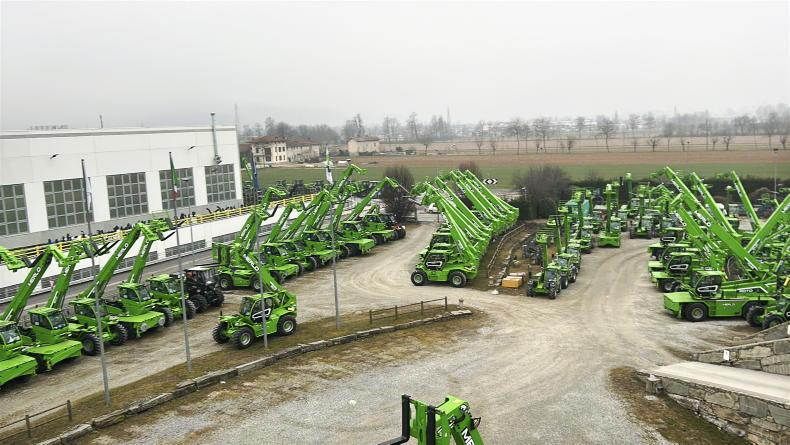
The large Cuneo facility currently covers more than 330,000 square metres.
By 1953, rapid growth of the business resulted in the Merlo family uprooting and moving to the Cuneo suburbs. A new 2,000m2 facility was built and the anvil and forge gave way to more modern machinery such as lathes and bending machines.
In 1964, the Merlo Company was born alongside the construction of a new 40,000m2 facility, which is very much central to the expanded site of today.
Two years later, Merlo started the production of dump trucks and self-propelled truck mixers, featuring a similar chassis and rotating turret to the earlier military vehicles.
The year 1981 represented a major milestone for the company when it launched its first telehandler, the SM30 with its distinctive rounded cab and curved windows.

The SM30 was the first telehandler built by the Italian company.
Other innovative features followed at the time, including the Panoramic XS – what Merlo claims was the world’s first telehandler with a side engine and low hinged boom.
In the years that followed, Merlo built what it also claims was the world’s first telehandler with a rotating turret out of which the Roto range was later born.
Yet another first for the industry, was the introduction of the Multifarmer in 2000, a unique range of telehandlers with rear three-point linkage offering tractor- like functionality.
Fast forward to today, the Merlo company is still owned by the Merlo family in its entirety. Paolo Merlo is the current company president and CEO while his sister and brother, Silvia and Andrea Merlo, also hold executive roles. The Merlo Group comprises nine subsidiaries, and a distribution network of over 50 importers and 800 dealers in more than 80 countries. The company employs in excess of 1,700 people.
Divisions and product ranges
Merlo is more than just a manufacturer, the group, in fact, has a number of separate product divisions. These include:
TreEmme: a range of tool carriers for the forestry sector. Techno: equipment for commercial vehicles, particularly waste collection equipment.Merlo Project: technologies division.Movimatica: fleet management software.CFRM: training and research centre.Merlo manufacturers 100% of its agri and construction machines in the one factory in Cuneo. The factory currently builds 8,000 machines a year, 81% of which are exported. When we visited, senior management had spoken about the goal of increasing annual production to 11,000 machines in order to better facilitate and grow the brand’s presence in certain export markets, namely the US market.
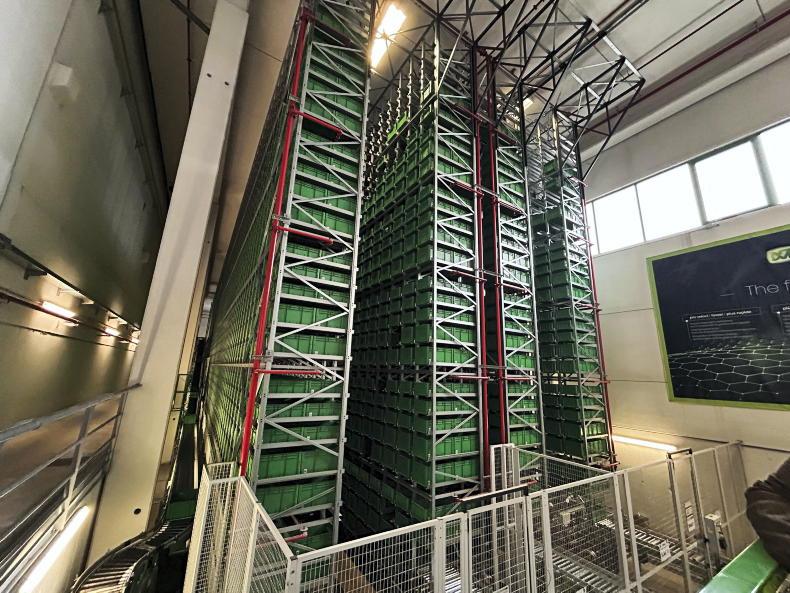
The automated parts handling facility can hold over 80,000 storage boxes.
However, this was prior to US President Donald Trump imposing trade tariffs on the European Union.
Telehandler design
When it comes to the thought process behind the design of Merlo telehandlers, it is very much a case of practicality, performance and comfort. Safety and vision are also two key traits which the firm achieves with a low boom pivot height.
Practicality is evident. For example, rather than fitting a large rear counterweight like some manufacturers do, Merlo’s philosophy has always been to integrate the necessary weight within the chassis. The distinctive solid ‘ring of steel’ around its machines not only help in terms of protection, but stability and strength too.

Mattia Bodino, global event manager, showing the results of a machining process from raw steel to the finished component.
Considering the huge number of components that are manufactured in-house – including cabs, axles, plastic components, etc – Merlo opts to use a modular design which means there are a considerable number of shared components between particular models.
Factory
Merlo prides itself in designing and manufacturing over 92% of components in-house. The original facility has been built up over the years to now cover 330,000m2. An interesting fact about the factory is that Merlo has not only just expanded outwards but also upwards and downwards. For example, there is an additional 80,000m2 of production space below ground.

The paint line was designed in 2005 to be vertical in order to better accommodate expansion.
The factory currently uses in excess of 70,000t of steel annually, all of which is sourced within Northern Europe, predominately from Sweden and Ukraine.
Under the one roof, Merlo manufactures, its entire agri and construction portfolio, from Cingo tracked dumpers to its extensive telehandler ranges and attachments. The facility is also responsible for the TreEmme forestry tool handler tractor.
Manufacturing process
Starting at the beginning, all raw steel is dry stored where it is then lifted magnetically and processed. There are a total of five laser cutters, two plasma cutters and one oxy-fuel cutter which can cut steel up to 30cm in thickness.

Underneath the factory floor is a vast storage facility and transport rail accessed by lift shafts.
Throughout the factory there are numerous CNC press brakes, the largest of which can apply up to 1,000t and bend steel up to 8.1m long. It is predominately used to fold telehandler boom sections from flat sheet. All components throughout the process are etched with a unique barcode for full traceability.
The company has and continues to invest heavily in automation, particularly in terms of robotic welding and robotic machining. With a total of 25 robotic welding stations throughout the factory, all welding is now done robotically. Each welding robot allows a 30% increase in throughput when compared to manual welding. In fact, the company strives for a 30% productivity increase from any production process upgrade.
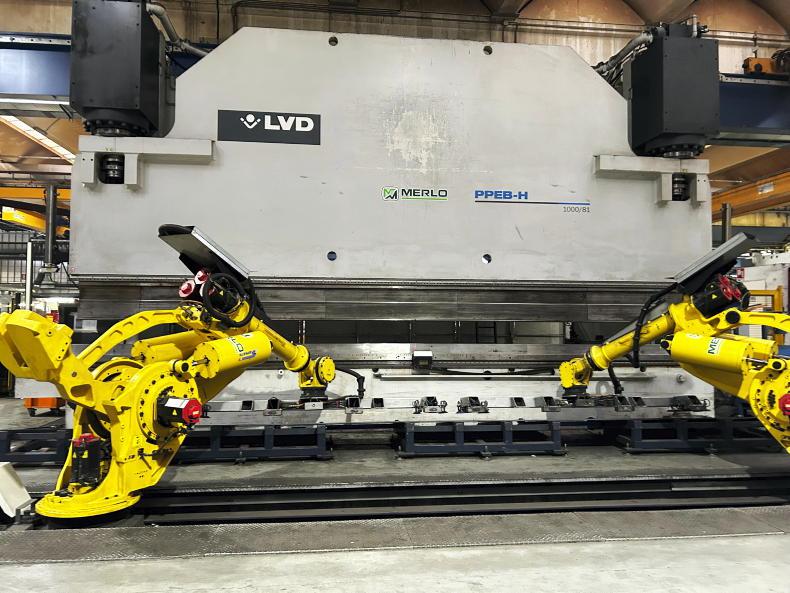
Merlo partners with machine suppliers to better develop and tailor machines to suit its process.
A large proportion of the machining is now done robotically, ensuring accuracy and speed. In total, there are 19 machining robots. The first chassis-machining robot was fitted in 2019 with a second on the way. These machines are capable of alternating between the required tooling throughout the machining process and can machine up to 40 chassis daily. All swarf is collected via conveyor and compressed into small pucks for recycling.
Self-independence
Visiting the facility, gives a real insight into the full extent of Merlo’s independence. Leaving aside the fact the company builds 92% of its own components – including axles, transmissions and cabs etc – it also partners with certain suppliers to develop the best solution possible for the exact process at hand.
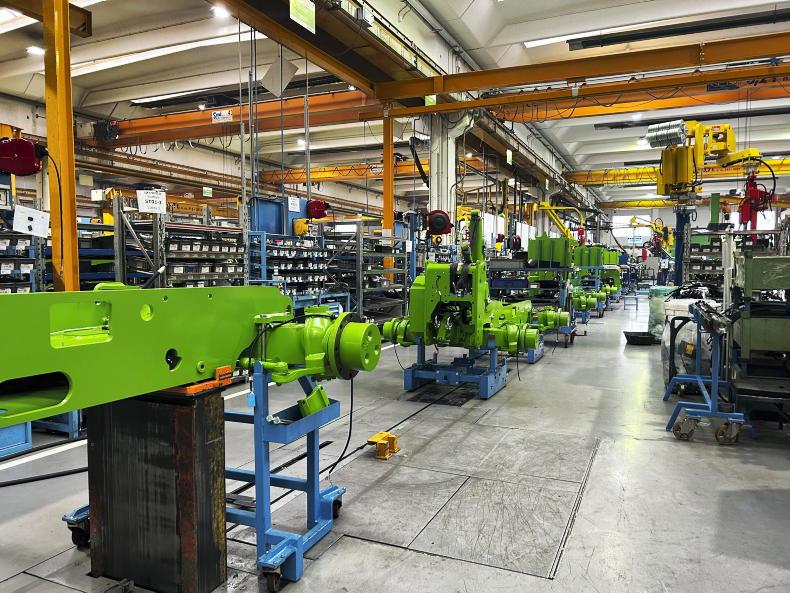
There are dedicated assembly lines specific to particular product ranges.
This explained the reasoning behind the Merlo stickers on the majority of the factory’s robots.
All plastic mouldings are manufactured in-house using an impressive lineup of injection moulders. These components range from dash plastics to accelerator pedals. Merlo believes that having so much control over design and production leaves its designers free to design a machine that contains only purpose-built parts and not a machine that has been designed around parts bought in from a third-party supplier. Engines are sourced from Perkins, Kohler and Deutz – these being one of the few components exempt from this strategy as expected.
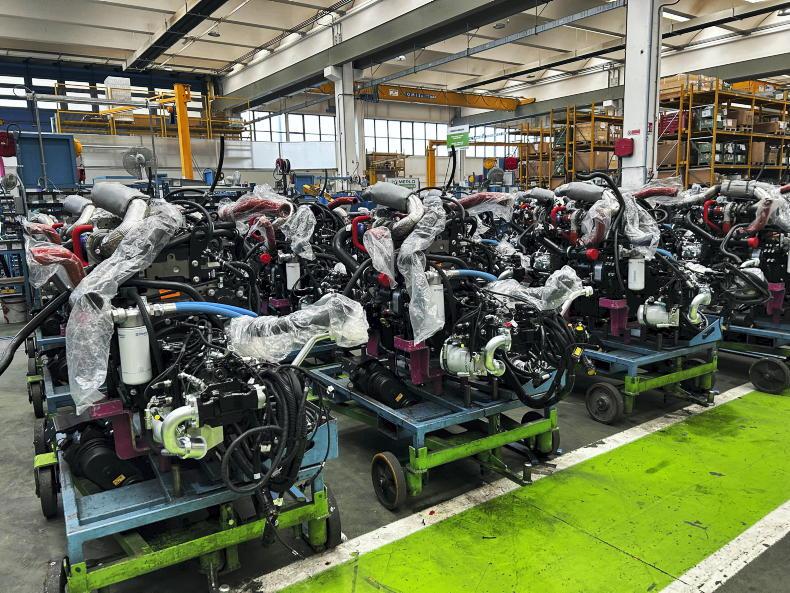
Engines are sourced from Kohler, Perkins and Deutz.
Below the factory floor, there is a vast storage facility which is all accessible via rail network. For example, the network is used to automatically transport material such as cut steel for the chassis right through to the required assembly point. This not only avoids surface traffic, but is a more efficient use of space.
Merlo takes a huge amount of pride in adequate staff training.

The majority of axles for Merlo products are made in-house.
New staff members go through a six-week training programme before being allowed on to the factory floor. The design team involves over 180 engineers, not all of who work directly on the product range.
Paint process and part storage
Merlo use a state-of-the-art powder coat paint process. Originally installed in 2005, it was built using a vertical approach so that output could be later increased, which it was. During the extension phase, the factory roof was raised by 7m which now sees it capable of painting 50 machines daily. In total, the paint line is 240m long.

There is a dedicated building responsible for the injection moulding of almost all plastic components.
There are a number of production lines dedicated to the various product ranges, from its Cingo tracked loaders to its Turbo Farmers and TreEmme tool handlers. The cab assembly line spans 42m through seven stations. The majority of products and models are built using a batch-production strategy.
Once assembled, all machines are driven off the production line where they undergo and inspection process before sign off for delivery.

In 2020, the automated spare parts storage facility was doubled in size, taking capacity up to 80,000 boxes.
In 2015, an automated spare parts storage facility was built to accommodate 40,000 parts. This was then doubled in 2020. What makes the storage facility even more impressive is the fact it extends to 15m below the surface.
Future plans
Merlo outlined its ambitious plans over the coming years to not only introduce new models but to further extend assembly lines, loading and testing area. It also expressed intentions to invest in new manufacturing processes and R&D facilities within the coming two years. This will include a new two-storey building dedicated to electronics and hydraulics.

TreEmme tool carriers for forestry mulchers are also built on site.
Arguably ahead of the curve, Merlo showcased an award-winning diesel electric hybrid telehandler in 2014. Since then, the company has brought to market its E-Worker compact electric telehandler and continues to develop larger fully electric machines, one of which remains in the concept phase. An electric test mule fitted with a new cab and styling was undergoing testing on site - potential updates we can expect to see in due course.

Merlo has plans for future expansion of the facility.
All in all, it’s impressive to see the family run business still do so much manufacturing in house in 2025 and continue to go from strength to strength.
Business: Merlo.Established: 1964. Owned by: Merlo family.Production: 8,000 machines/year.Export markets: 80+. Percentage of machines exported: 80%+.Employees: 1,700.Factories: 1.Factory size: 330,000m2.Subsidiaries: 9.
Merlo currently produces over 8,000 machines annually.





SHARING OPTIONS: